The Development of Ancient Greek Art Is Best Understood as
Greek fine art as we know it started around 650 BCE and lasted to around 27 BCE. This period of aboriginal Greek art is rich with cultural and socio-economical history, shaping its very essence and informing it equally much as it informs us. It would take a meaning amount of time to acquire all in that location is to know about ancient Greek fine art, which predominantly constitutes of pottery, architecture, and sculpture.
Table of Contents
- 1 A Footling Bit Nearly Hellas
- two Historical Foundations: What Are the Origins of Ancient Greece?
- 2.ane The Stone Historic period
- two.2 Into the Bronze Age of Hellenic republic – The Aegean Civilizations
- three The Greek Night Ages and the First of Greek Civilization
- 4 Greek Art and Architecture Characteristics
- four.1 Archaic Period (c. 650 – 480 BCE)
- iv.2 Classical Period (c. 480 – 323 BCE)
- 4.3 Hellenistic Menstruum (c. 323 – 27 BCE)
- 5 To Rome and Beyond
- 6 Frequently Asked Questions
- vi.one What Were the Stages of Greek Art?
- six.2 What Does "Classical Lodge" Mean?
- vi.3 What Are Some Greek Art Characteristics?
A Lilliputian Chip About Hellas
Before we get-go with Aboriginal Greek art, let united states explore the magnitude with which we are engaging, namely, Hellenic republic. When we think of Greece, or Hellas, which is its Aboriginal Greek translation, we immediately know more-or-less the touch this ancient civilization had on shaping our Western civilisation.
Greece is a bustling geographic hotspot on the earth map – its location is in Southeast Europe with its capital letter existence Athens. The country is divided into nine regions, namely the Aegean Islands, Central Greece, Crete, Epirus, Ionian Islands, Macedonia, Peloponnese, Thessaly, and Thrace. It is also located most to where Africa, Asia, and Europe converge and borders Albania, Northward Macedonia, Bulgaria, and Turkey.
The seas that surround Greece include the Aegean Bounding main (this is towards the East of the mainland), the Ionian Sea (this is towards the W), and the Cretan and Mediterranean Seas (this is towards the Due south). There are besides numerous islands surrounding Greece.
 Map of Ancient Greece past Matthäus Seutter, 1740;Matthäus Seutter, Public domain, via Wikimedia Commons
Map of Ancient Greece past Matthäus Seutter, 1740;Matthäus Seutter, Public domain, via Wikimedia Commons
We also know the famous Mountain Olympus, which is Greece's highest mount with Mytikas, its highest pinnacle, at 9,570 feet. Olympus is worth noting equally it holds an important place within Greek Mythology, existing equally the place where the gods would reside with Zeus on the throne.
Greece is likewise widely considered as the "cradle" or "birthplace" of Western culture. It was the starting signal of diverse cultural and political doctrines, for case, democracy and philosophy. It also explored and developed various principles related to mathematics and science. In culture, it set the stage for drama, art, architecture, pottery, sculpture, and literature, and in sports, the Olympic Games, which is still ongoing in our nowadays twenty-four hours and age.
Historical Foundations: What Are the Origins of Aboriginal Greece?
The best manner to understand the historical foundations of aboriginal Greece is to wait at its diverse periods throughout its development as a civilization, equally at that place are numerous timeframes and stages of progression. Notably, Greece goes back all the manner to prehistory with the Stone Age, which ended effectually 3,200 BC, and so into the Bronze Age, which started around 3,200 BC.
The Stone Age
The Stone Ages were divided into three distinct periods, namely, the earliest, Paleolithic, followed by the Mesolithic, and then the last, the Neolithic. During the Neolithic Greek Historic period (7000 BC-3200BC), there was an increased development of farming and stockbreeding, also every bit new advances in architecture and diverse tools used.
The Neolithic Greek Age was farther divided into six stages, namely, Aceramic (Pre-Pottery), Early Neolithic, Center Neolithic, Belatedly Neolithic I, Late Neolithic Ii, and Concluding Neolithic. With every micro-period within the Neolithic Age, there were new developments in farming and civilisation.
Information technology is important to understand that these periods set up the stage, then to say, for Ancient Greek art.
It was during the Early Neolithic catamenia when people developed techniques to burn down vases. The Middle Neolithic menses brought with it new developments in architecture, namely the "megaroid", also referred to every bit the "megaron". This was a rectangular-shaped business firm with ane bedroom and porches (open or closed), and it would also accept columns at the front entrances.
The importance of the megaron structure is that information technology developed into the hall for Greek palaces. It is one of the primary characteristics of Greek architecture, also described every bit being "rectilinear" in shape. This would also become the shape for Greek temples.
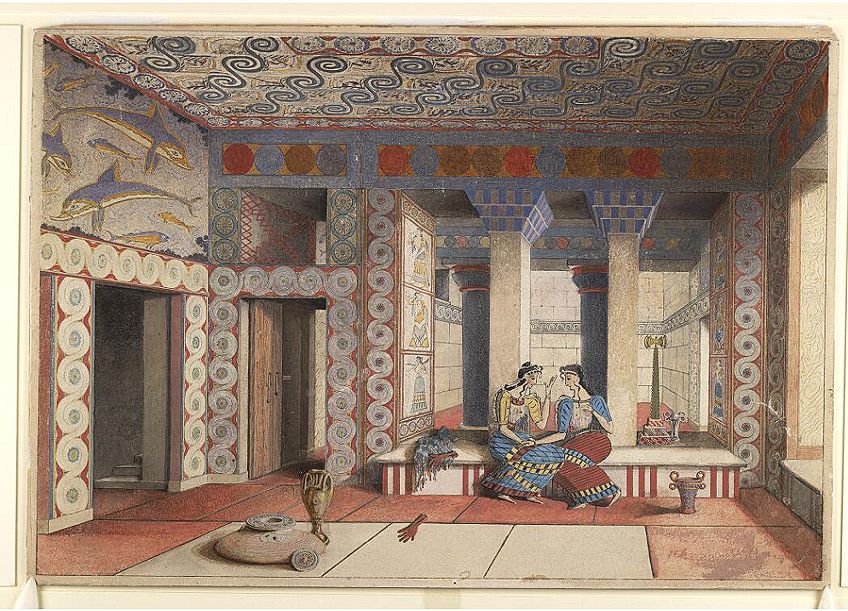 Romantic reconstruction drawing of the "Queen's Megaron" by Emile Gilliéron the younger. From the papers of Arthur Evans relating to excavations in Crete, between 1922 and 1926;Gilli‰ron, Ðmile fils, CC By 4.0, via Wikimedia Commons
Romantic reconstruction drawing of the "Queen's Megaron" by Emile Gilliéron the younger. From the papers of Arthur Evans relating to excavations in Crete, between 1922 and 1926;Gilli‰ron, Ðmile fils, CC By 4.0, via Wikimedia Commons
Other architectural developments were the "Tsangli" construction, which was a settlement. This structure included two buttresses inside the house to add together additional support for the roof. There were too rooms designated for unlike purposes. Houses during this menstruum developed better foundations fabricated of stone compared to the huts during the earlier stage. During the after Neolithic periods, there was an increase of advancements in farming and agriculture, and this period moved into the Bronze Age when people imported copper and bronze metals.
The Neolithic Greek Age occurred in diverse locations effectually Greece, namely, Athens, Dimini, Franchthi Cave, Knossos, Milos, Nea Nikomedeia, and Sesklo.
Into the Bronze Age of Greece – The Aegean Civilizations
The Greek Bronze Age is categorized by three ascendant locations, and is also referred to as the Aegean Civilization, which was centered effectually the Aegean Sea. The primary locations were, namely, the Cyclades, which are islands located southeast from the mainland of Greece, Crete, which lies more south of the mainland of Greece, and and so there is the Greek Mainland.
Each geographic surface area had different cultures. The Cycladic civilization (circa 3300-2000BC) from the Cyclades, the Minoan culture (circa 2700-1100 BC), which was from Crete, and the Mycenaean civilization (circa 3200-1050), which was from Mainland Greece. The evolution of each civilization overlapped with the other, although the Mycenaean culture eventually absorbed the Minoans.
Some of the notable features of these periods include writing, known every bit Linear A and Linear B, more trade, and various new tools.
The Cyclades civilization created female person figurines, or idols, fashioned out of marble. Many of these appear with big oval faces and elongated noses. The main sites for this civilization were Keros, Grotta, Phylakopi, and Syros.
The Minoans were largely located at Knossos, and other areas like Malia, Phaistos, and Zakros. The Minoans are known for having provided the earliest foundations for European Culture. Their civilization was avant-garde in many ways, from not simply writing and more extensive trade (traveling to places similar Egypt exposed them to different cultures), merely their art and architecture consisted of ancient Greek paintings similar frescoes, which were brightly painted of field of study matter like animals from the land and bounding main, and landscapes of nature. These were oft painted within the palaces. The frescoes would as well have borders in decorative patterns.
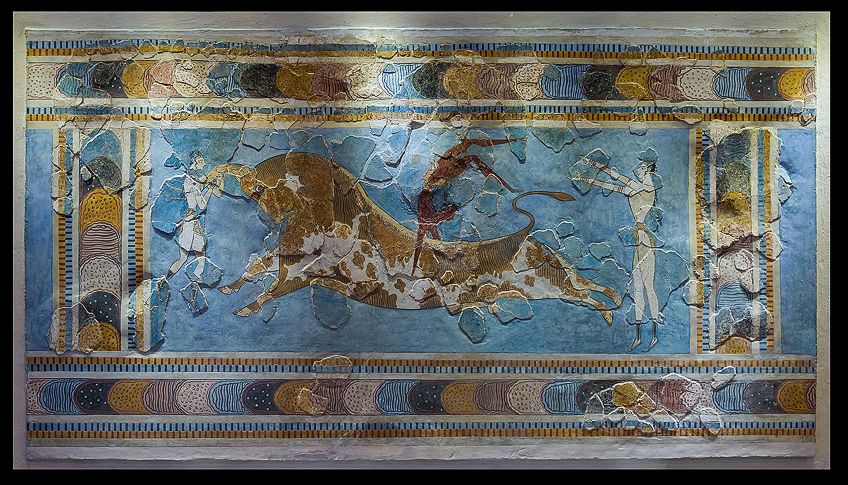 Toreador Fresco (Balderdash-Leaping Fresco) (c. 1600-1450 BC), found in Knossos palace, Crete, Hellenic republic. Part of a 5-console composition, the iconic Toreador Fresco depicts an acrobat at the back of a charging bull. A second figure prepares to leap, while a third waits with arms outstretched;Heraklion Archaeological Museum, CC0, via Wikimedia Commons
Toreador Fresco (Balderdash-Leaping Fresco) (c. 1600-1450 BC), found in Knossos palace, Crete, Hellenic republic. Part of a 5-console composition, the iconic Toreador Fresco depicts an acrobat at the back of a charging bull. A second figure prepares to leap, while a third waits with arms outstretched;Heraklion Archaeological Museum, CC0, via Wikimedia Commons
Beyond aboriginal Greek paintings, the Minoans besides produced a broad multifariousness of greek pottery and ceramics. Examples of the different shapes of vessels include the amphora (with 3 handles), various beakers, rounded vessels, and storage jars referred to as pithos. Ceremonial jugs were fabricated to contain libations for rituals, and these were known as rhytaand made in the shape of an beast'southward head.
The bull was a significant animal in their civilization, and they would oft depict the bull's horns in their art and decorations. The Minoans too had gold jewelry, sculptures, and palaces built to the height of four stories. Palaces were pregnant features in the Minoan civilization, and alongside their extensive layouts, various farming communities surrounded a fundamental palace, and roads were made to connect the farms or villages.
The Mycenaean civilization was located mainly in Mycenae, and other areas like Athens, Thebes, Pylos, Sparta, among others. It is also referred to as the "Helladic" menstruation. Since the Mycenaeans lived on Mainland Hellenic republic, they are also described as "indigenous".
Trading was common among this civilization, namely in goods similar golden, glass, copper, and even ivory.
The Mycenaeans created artworks that were influenced by the Minoan civilization. They were known every bit having a strong warrior culture when compared to the Minoans. The Trojan War is a famous state of war and is popularized to this day through films similar Troy. When we look at frescoes created, the Mycenaeans also depicted a variety of scenes relating to battle, animals, nature, warriors marching with their weapons, and diverse other subject matter similar to that of the Minoans.
In fact, the similarities between Mycenaean Art and Minoan Art are often noted, although Mycenaean Art is described as appearing more than "geometric" and "formal" in its style. Withal, there would have been merchandise betwixt Crete (Minoans) and Mycenae, which explains the styles of fine art converging between the two cultures.
The well-known Panthera leo Gate (c. 1250 BC) is one of the lasting remnants of an architectural "relief" sculpture, depicting two lions (or lionesses) facing one another, standing on their hind legs with their front legs resting on a block-like base of operations, with a column in the center between the ii animals. The King of beasts Gate is located every bit the main entryway to the acropolis, which is where the palace and citadel were situated.
 Relief of the Lion Gate(c. 1250 BC), Mycenae;Zde, CC BY-SA 4.0, via Wikimedia Commons
Relief of the Lion Gate(c. 1250 BC), Mycenae;Zde, CC BY-SA 4.0, via Wikimedia Commons
The Greek Dark Ages and the Beginning of Greek Culture
The Mycenaean civilisation concluded effectually 1100 BC. The fall of this civilization and many others around that period is a widely debated topic. Many sources point to invasions by the Dorian civilization, climate changes, natural disasters like earthquakes, and other social bug like famine and overpopulation.
This period is referred to as the "Late Statuary Age Collapse", which would eventually go what is known as the "Greek Dark Ages". This menses started effectually 1100 BC to around 750 BC. It was also referred to every bit the "Homeric" period, which related to Homer's poems the Iliad and the Odyssey.
Almost congruent with the above-mentioned periods, the Geometric period (900-700 BC) occurred near the terminate of the Greek Nighttime Ages, and in the context of style, art on pottery was depicted in geometric shapes, which gave this period its name. It was after this period that Greece started to develop and evolve.
After this, there was an increase in population and ancient Greek fine art actually took shape, embodying the ideals of Classical Art as we now know it.
Greek Art and Architecture Characteristics
When we look at Greek art, nosotros call up in terms of idealized marble sculptures and homo figures that appear equally perfect and cute as a supermodel. At that place were three distinguishing periods in Greek fine art that characterized its evolution. Below, nosotros await at these three periods along with various characteristics and notable artists inside each.
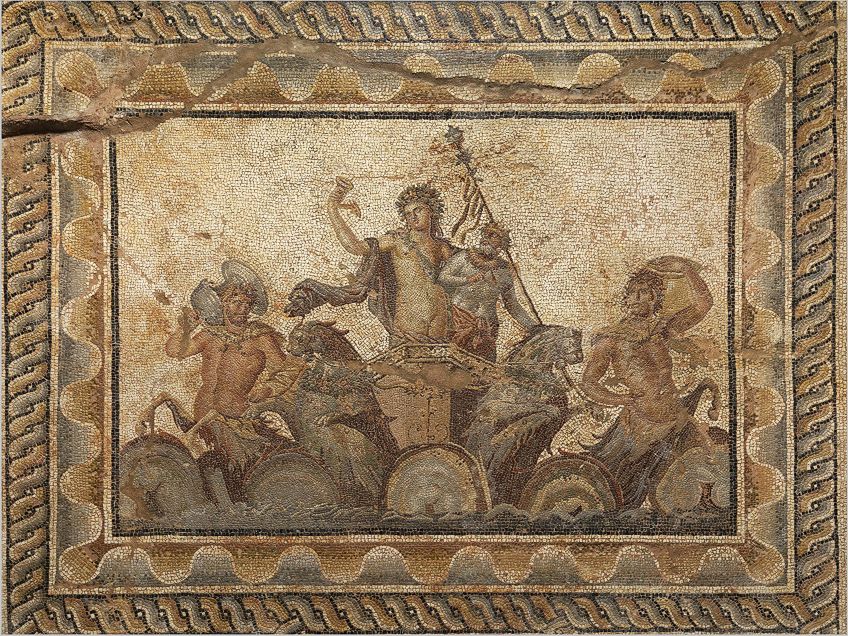 Epiphany of Dionysus mosaic, from the Villa of Dionysus (second century AD) in Dion, Greece. Now in the Archeological Museum of Dion; Anonymous Unknown author, Public domain, via Wikimedia Commons
Epiphany of Dionysus mosaic, from the Villa of Dionysus (second century AD) in Dion, Greece. Now in the Archeological Museum of Dion; Anonymous Unknown author, Public domain, via Wikimedia Commons
Archaic Menstruation (c. 650 – 480 BCE)
The Primitive Catamenia occurred with the onset of the Greek Olympic Games in 776 BC, which is often noted every bit when this period truly started. Politically and socially, this period also saw the start of the city-land, referred to as polis, which means "city" in Greek. These poleis were mainly ruled nether tyranny, although there is also debate that this tyrannical dominion was non the same as what information technology became in later years. Tyrants substantially assisted communities to go more than expansive in wealth and work opportunities.
Fine art during the Primitive Catamenia is described as more naturalistic in its portrayal compared to the Geometric flow. Some of the primary forms of artwork were pottery, painting, sculpture, and compages. Because of trade betwixt various Eastern countries, there was a wide Oriental influence noticeable on vases and vessels. More animals similar lions, griffins, and sphinxes were painted and artists employed decorative motifs like curves and floral patterns.
The man form was also depicted not only in painting on pottery but besides in sculpture. This is axiomatic in the various life-sized figure sculptures created from stone. While there was realism in their portrayal, there was as well an idealism largely influenced past the Mycenaeans and the show of strength and physical prowess of the masculine form.
This was largely displayed in the athletes and warriors of the time, marking the Mycenaean culture as a "Golden Age" because of the bravery and heroism.
The human form in sculpture during the Primitive Menstruation is seen in well-known examples referred to as kouros ("young boy") and kore ("young girl"). These statues were in a "frontal" stance, bearing influence from Egyptian statues at the time, as well every bit existence "freestanding". The features that characterize them include an upright stance with arms at the sides, feet closely next to the other, and broad shoulders.
 Statue of a kore (left) and a kouros (right), both made from Parian marble. Found in Merenda (ancient Myrrhinous), Attica. Both are important works of the ripe Primitive mode and its menstruum;George E. Koronaios, CC Past-SA iv.0, via Wikimedia Commons
Statue of a kore (left) and a kouros (right), both made from Parian marble. Found in Merenda (ancient Myrrhinous), Attica. Both are important works of the ripe Primitive mode and its menstruum;George E. Koronaios, CC Past-SA iv.0, via Wikimedia Commons
The female analogue, the kore, was often depicted wearing dresses of their time with some stylistic elements. In both types of statues, nosotros run into what is referred to as the "archaic smiling", which gives the appearance of softness and tranquillity for both male person and female statues. This is a notable characteristic as it symbolizes idealism.
Furthermore, the purpose for these statues varied, for instance, the korai were used as votive offerings to Greek goddesses like Athena. The kouroi were used as memorials to either deceased individuals or given to winners of games played and competed in.
There are numerous reasons why these statues were used; some also believe they were of the god Apollo and made to resemble Greek deities.
Examples of Greek sculptors and Athenian arts during this menstruum include the Athenian, Kritios, who worked in the afterward stages of the Archaic Period. He is considered to have profoundly influenced the more than realistic artistic styles in sculpture in the subsequent Classical Period. He is known every bit being the student of the sculptor named Antenor (c.540-500 BC), who created The Tyrranicides (510 BCE).
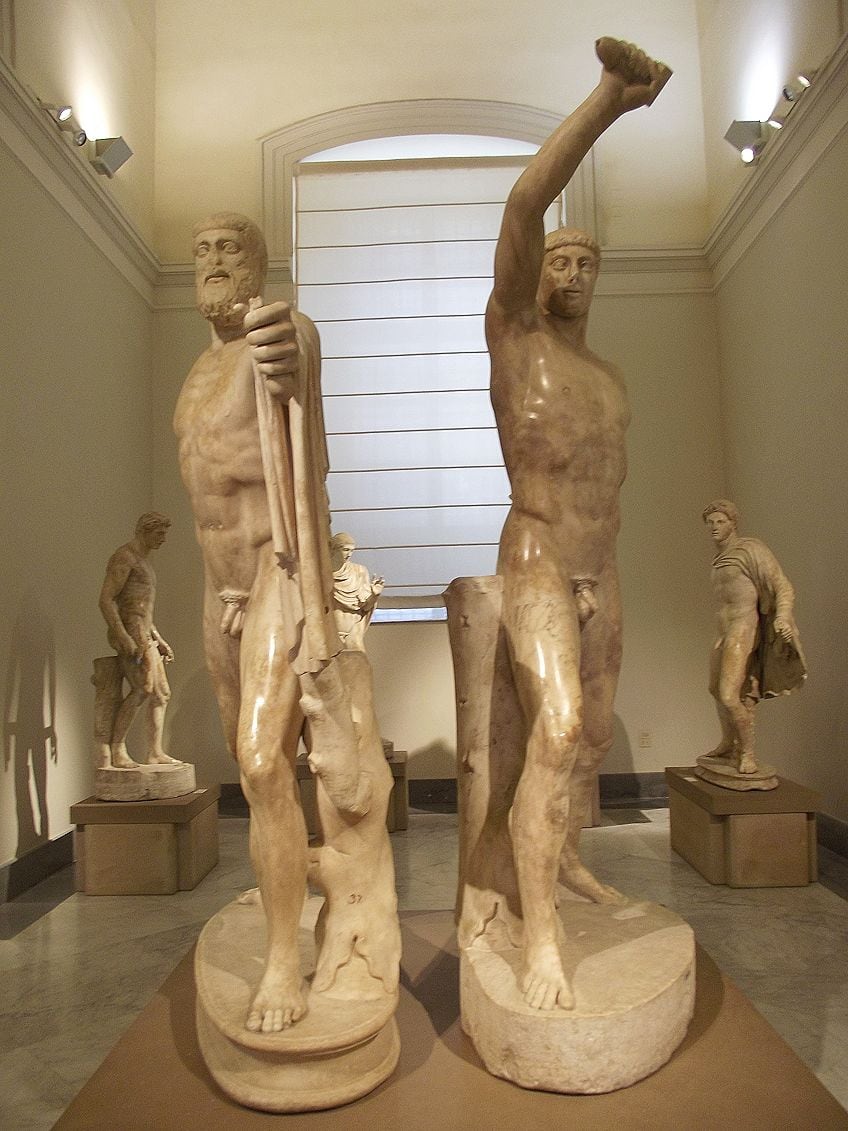 Statue of Harmodius and Aristogeiton, part of the Tyrranicides group;Elliott Brown, CC Past 2.0, via Wikimedia Eatables
Statue of Harmodius and Aristogeiton, part of the Tyrranicides group;Elliott Brown, CC Past 2.0, via Wikimedia Eatables
Tyrranicides was deputed by Cleisthenes, a political leader who set up the foundations for democracy in Athens during the 6thursday Century BC. He was remembered as the "founder of Athenian democracy". The sculpture depicts the two figures, Harmodius and Aristogeiton, who assassinated the tyrant Hipparchus.
Kritios recreated this sculpture with some other sculptor called Nesiotes after information technology was taken by Xerxes I during the state of war between Persia and Greece. Kritios is as well famous for his sculpture named Kritios Boy (c.490-480 BCE). In size, it is recorded as being smaller than a life-sized sculpture.
Equally an Early Classical Catamenia piece, Kritios showed Greek sculptors a new fashion in depicting the human figure. We also see this technique unremarkably utilized in Renaissance and Neoclassical paintings and sculpture, and is referred to equally "contrapposto" – the Kritios Male child is standing with his weight on one leg, giving the torso a slight "S-Curve".
Kritios sculpted all the anatomical accuracies inherent in a posture like this one. Nosotros see how the left hip is elevated and the buttocks on the right is not tensed. Other features of this work show the dropped left shoulder, the rib cage actualization as if the figure is inhaling due to its expansion, and the facial expression, which is non as idealized as we see in previous Early Archaic sculptures.
Kritios is described every bit producing work that is more "severe" in style. This is exemplified in the figure's oral cavity; it is not the "archaic smile" we so often meet from the idealized expressions of before, but appears more serious in expression.
This work is now housed and displayed in the Acropolis Museum in Athens with many other Athenian arts. The statue was one of many other aboriginal Greek artifacts found in the "Persian Rubble", called Perserschutt, left behind past the Farsi invaders later on they sacked the Acropolis during 480 BC.
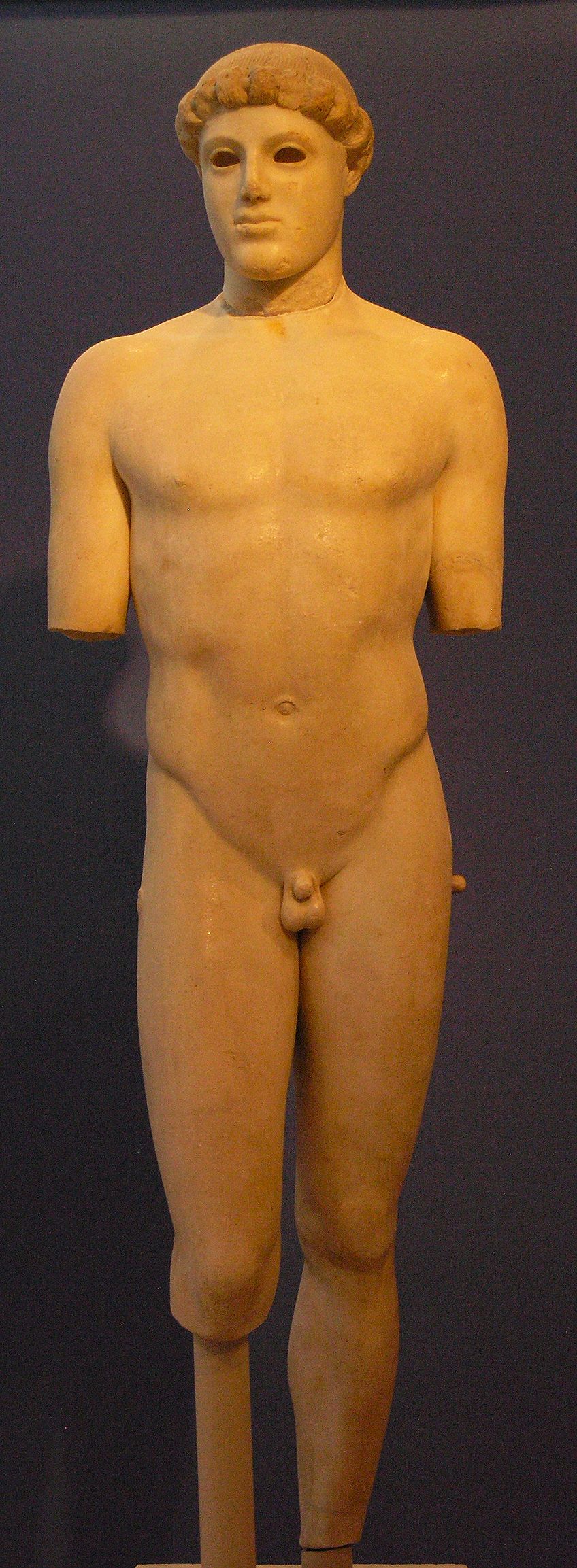 Kritios Boy (c. 480 BC) by Kritios; Critius, CC BY-SA 2.five, via Wikimedia Commons
Kritios Boy (c. 480 BC) by Kritios; Critius, CC BY-SA 2.five, via Wikimedia Commons
Classical Flow (c. 480 – 323 BCE)
Where the Archaic Menses is often described equally beingness experimental in its portrayal of realism in the human course, the Classical period was a considerable advancement forrard, depicting a naturalism in the human form. This period in Hellenic republic was besides considered the "Golden Historic period" because of the Greeks' victory over Persia, which is known as the Greco-Persian State of war.
This new flow of peace and victory gave birth to many new developments in not merely arts and architecture, but philosophy (with some of the greatest philosophers of Western history, namely, Socrates, Plato, and Aristotle), science, and politics. The urban center-state of Athens was too rebuilt after the war.
The "Golden Age" lasted for around 50 years until the Peloponnesian War in 431 BCE, where Sparta won power over Athens. Withal, the Macedonian war then took over the Greek states, nether the dominion of King Philip Ii and then his son, Alexander the Great.
The philosophies of Plato and Aristotle had a profound effect on Greek artwork and how Greek artists depicted the homo figure. Plato also started an academy in Athens (c.387). This ushered in new means of thinking, making reason and knowledge an of import determining gene that underpinned many beliefs and perspectives.
 Plato'southward Academy mosaic (from Pompeii, c. first century), at present at the Museo Nazionale Archeologico, Naples; Naples National Archaeological Museum, Public domain, via Wikimedia Commons
Plato'southward Academy mosaic (from Pompeii, c. first century), at present at the Museo Nazionale Archeologico, Naples; Naples National Archaeological Museum, Public domain, via Wikimedia Commons
Classical Greek Sculpture
Art became a representation of the natural. In other words, it became truthful to nature and true to real-life proportions. Greek artists began to create sculptures that appeared human-like and detailed, but still beautiful and perfected. This brings us to what was known as the "Canon of Proportions".
This term refers to the perfect artwork, or then according to Greek sculptor Polykleitos. He adult what was termed "The Canon" (circa 450 BCE), a set of ratios based on mathematical measurements of the human body to depict each body part in perfect club and symmetry – in other words, perfect proportion.
An case of this is in his sculpture Doryphoros ('Spear Bearer', c. 440 BCE), which depicts a nude male person warrior. This work has been reproduced in marble by other sculptors due to the original bronze sculpture being lost. However, the replicas indicate the ideal perfection of the male person grade obtained through mathematical measurements.
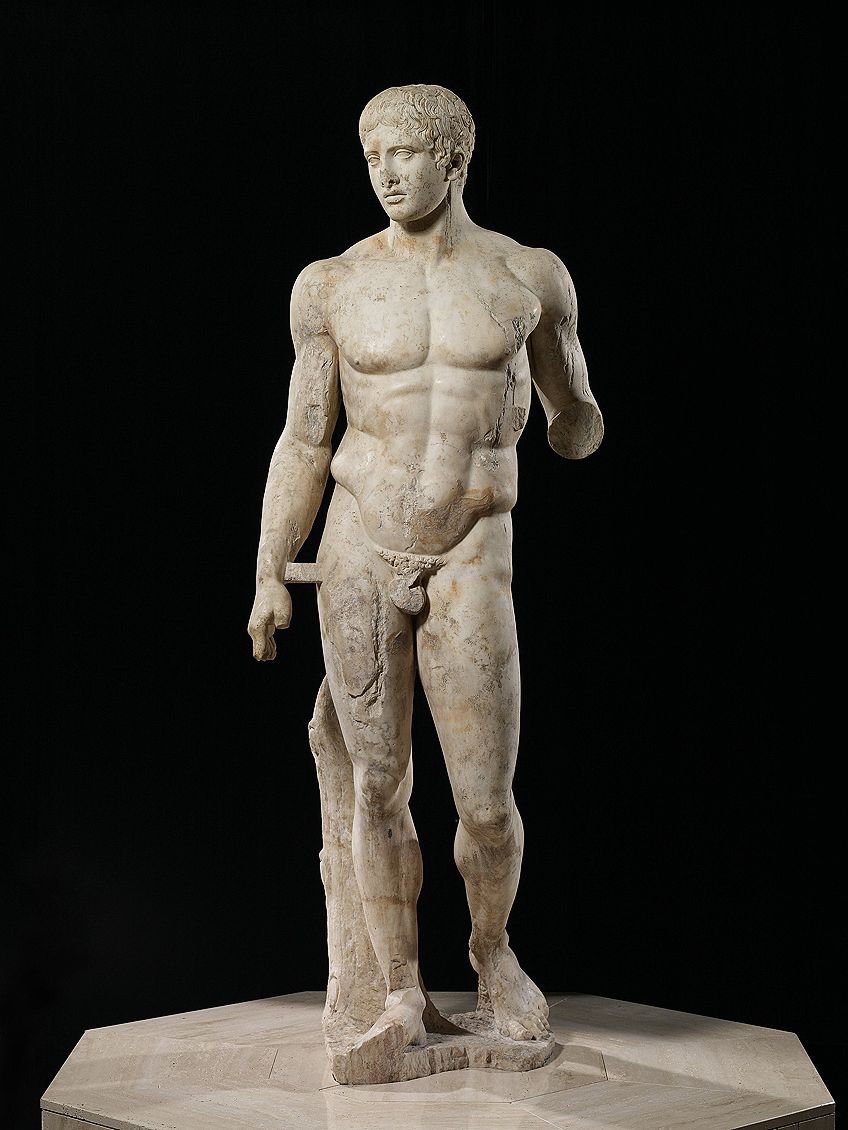 Doryphoros ('Spear Bearer', c. 440 BCE) past Polykleitos;Minneapolis Establish of Art, Public domain, via Wikimedia Eatables
Doryphoros ('Spear Bearer', c. 440 BCE) past Polykleitos;Minneapolis Establish of Art, Public domain, via Wikimedia Eatables
This sculpture was also a physical example of Polykleitos' theoretical underpinnings nearly achieving perfect form through proportions, which ultimately sought to illustrate harmony and perfect balance. The word "Catechism" means "rule" or "measure".
It was the interest in achieving and depicting the idealized human being figure, which was usually sought in the figures of male athletes and warriors, that became widespread in Greek sculpture. We besides see this in many other well-known Greek sculptors of the Classical period, such as Myron's classic Discobolus ('Discus Thrower', c. 425 BCE).
The Discobolus was originally in bronze but recreated by various Roman sculptors over fourth dimension in bronze and marble. Information technology is a male discus thrower portrayed fully in the act of throwing the discus. His body appears contorted to prepare for the throw, putting him in the classical contrapposto stance. We see his right arm behind him holding the discus, and his caput is turned in that management – whatsoever moment nosotros expect the arm to swing forward. This image creates a sense of naturalism in the human figure and displays each body part in correlation with the other.
 The Discobolus Lancellotti, Roman copy of a fifth century BC Greek original by Myron, Hadrianic period, Palazzo Massimo alle Terme;Carole Raddato from FRANKFURT, Germany, CC BY-SA 2.0, via Wikimedia Eatables
The Discobolus Lancellotti, Roman copy of a fifth century BC Greek original by Myron, Hadrianic period, Palazzo Massimo alle Terme;Carole Raddato from FRANKFURT, Germany, CC BY-SA 2.0, via Wikimedia Eatables
Praxiteles was another prominent sculptor of the fourth Century BC, famous for his life-sized female nude sculptures, of which he was a pioneer. One of his popular sculptures includesAphrodite of Cnidus (c. fourth Century BC), depicting the nude female holding a bathroom towel in her left hand (or reaching for one) while covering her genitalia with her correct hand, with her breasts uncovered.
A sculpture such as this was revolutionary at the time because all sculptures were typically washed of male nudes. Additionally, sculpting the Greek goddess as life-sized created further affect, and it was articulate that Praxiteles had set the tone for Greek sculpture in a daring new way. His Aphrodite was besides described past the famous Roman writer, Pliny the Elder, equally one of the finest sculptures fabricated.
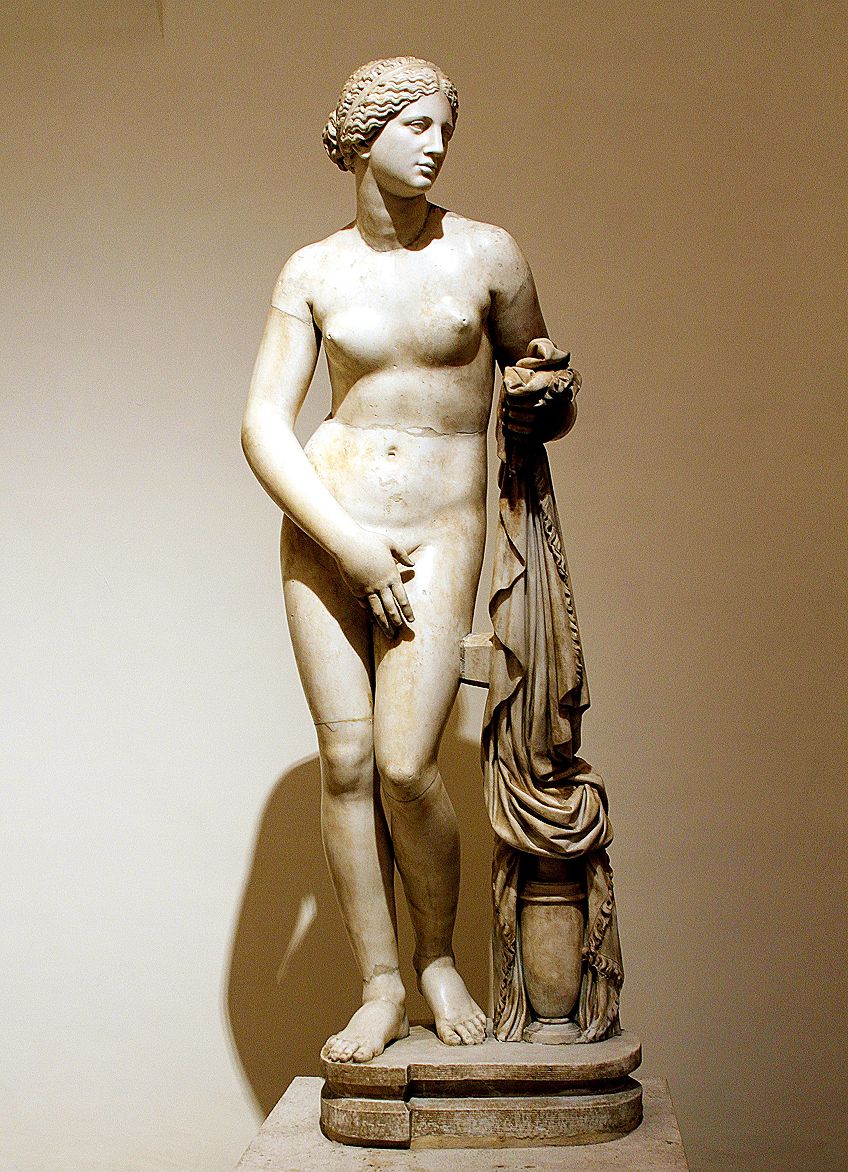 Aphrodite of Knidos (c. quaternary century BC) by Praxiteles;José Luiz Bernardes Ribeiro, CC BY 4.0, via Wikimedia Commons
Aphrodite of Knidos (c. quaternary century BC) by Praxiteles;José Luiz Bernardes Ribeiro, CC BY 4.0, via Wikimedia Commons
Classical Greek Architecture
The grandeur of Classical Greek architecture is illustrated by the famous Greek temple, the Parthenon (447-432 BCE). It is a large rectangular construction located on the Acropolis of Athens, which is a flat colina overlooking the city. It was designed by architects Ictinus and Callicrates in dedication to the Greek goddess Athena.
A monumental sculpture was housed in the center of the temple, titled Athena Parthenos. Information technology was created by a well-known Greek sculptor, Phidias. The sculpture was an example of the majesty of Athena and was around forty feet in summit and fabricated of ivory and gold (the goddess' skin was sculpted in ivory and her clothes were made from gold fabric).
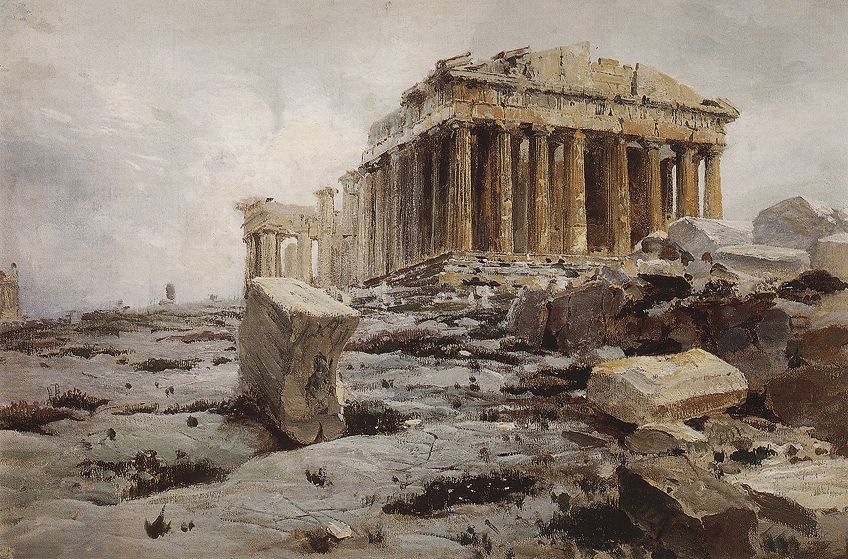 Parthenon by Vasiliy Polenov (1881-1882);Vasily Polenov, Public domain, via Wikimedia Commons
Parthenon by Vasiliy Polenov (1881-1882);Vasily Polenov, Public domain, via Wikimedia Commons
The Parthenon had multitudes of other sculptures and friezes surrounding it, including 17 Doric Order columns along the longer horizontal sides and eight along the shorter sides. The Doric Guild columns are a attestation to another architectural evolution inside this menses, namely the Doric and Ionic cavalcade styles. The latter, Ionic way, was also prominent in the subsequent Hellenistic period, from which the third, Corinthian style, also emerged.
As the first evolution of the architectural "Orders", the Doric style is plainer and described as "austere". It consists of the top of the column, known as the "capital", which is not decorated but evidently stone. The base rests without support on the stylobate, which is the upper step on a temple'south crepidoma (the leveled or tiered foundation that holds the superstructure). The departure betwixt the Ionic manner is that the uppercase is more than stylized and decorated, often described as being more slender in appearance than the robust Doric style. The Ionic column also includes a base to support it.
 A photograph of the Parthenon from the west;User:Mountain, Public domain, via Wikimedia Commons
A photograph of the Parthenon from the west;User:Mountain, Public domain, via Wikimedia Commons
Hellenistic Period (c. 323 – 27 BCE)
While the Classical Period is marked past beingness nether the dominion of Philip Ii of Republic of macedonia, near the end of this period, King Philip Ii was assassinated and replaced by his son, Alexander the Great. The Hellenistic Catamenia, or Hellenism, came into effect after Alexander's decease in 323 BCE. Yet, since Alexander did non take a successor, there was a period of uncertainty between all the generals.
This incertitude led Alexander's generals to define their power in different dynasties, withal, the Roman Democracy eventually took over Macedonia in 146 BC, and in 27 BCE, Emperor Augustus took over Hellenic republic and it became part of the Roman Empire.
The Romans were greatly inspired past Greek fine art and compages, and we will detect numerous replicas in marble done from Greek-inspired art.
During the Hellenistic Menstruation, Greek art became more diverse with a wider range of field of study matter, including not simply immature or warrior-like males simply everyday folk, including animals. Greek artists also moved abroad from depicting the ideal, as there was a heightened naturalism – almost to the point of existence dramatic – in sculpture and painting. Fine art was also commissioned by patrons and created as decorative additions to homes, such as bronze statues.
Hellenistic Greek Sculpture
Greek sculptures appeared more emotive in expression during this period. Considering the rigidity and idealism of the "archaic smile" from the preceding periods, there has been considerable evolution in depicting the man form and going across its physicality. There is a focus on drama and emotion with this period often described as being more pro-theatrical in art and architecture.
Many famous sculptures were created during this period, such every bitColossus of Rhodes (c. 220 BCE) by Chares of Lindos, which was around 110 feet in meridian. This magnificent statue was a male figure oft described equally beingness a dedication to Helios, the lord's day god. Unfortunately, this statue was destroyed during an earthquake.
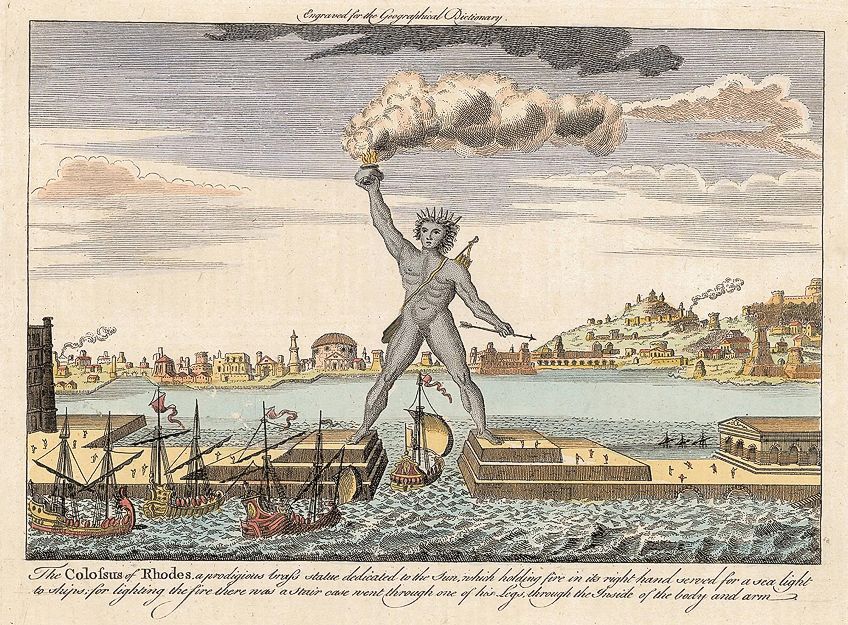 Colossus of Rhodes (c. 220 BC); Unknown author Unknown author, Public domain, via Wikimedia Commons
Colossus of Rhodes (c. 220 BC); Unknown author Unknown author, Public domain, via Wikimedia Commons
Another sculpture isThe Dying Gaul (c. 230-220 BCE) by Epigonus. This depicts a typical example of the expressive nature of Hellenistic sculptures. The effigy is of a Gaul, as is evident from his haircut and the ring around his neck, otherwise referred to as a "torque". He is in the process of dying, which is shown in his posture equally well as the broken sword lying next to him. What makes this sculpture so unique is that it captures a moment of expiry, inevitably evoking emotions in the viewer, which is what would have occurred for and then many Greeks viewing this piece.
 The Dying Gaul (c. 230-220 BC) by Epigonus;Capitoline Museums, CC BY 2.0, via Wikimedia Commons
The Dying Gaul (c. 230-220 BC) by Epigonus;Capitoline Museums, CC BY 2.0, via Wikimedia Commons
Other notable sculptures include the famous Venus de Milo (130-100 BCE) by Alexandros of Antioch. Here, we see a female figure (missing both arms), supposedly Venus, the Greek goddess of love. However, various scholarly debates suggest information technology could either be a prostitute or the sea goddess, Amphitrite, considering the statue was found on the volcanic island of Milos (located in the Aegean Body of water) in 1820.
We will find the familiar contrapposto ("S-Curve") posture in this sculpture, which is fabricated evident by the draping of her robe around her lower body and her left leg being slightly elevated. There is also a hint of sensuality with her exposed upper torso and the robe that is merely about to slide off her legs. In that location appears to be a dramatic element to how she is posed, agai evoking attention from onlookers.
 Venus de Milo (130-100 BCE) by Alexandros of Antioch, in the Musée de Louvre;Edwin Lee, CC BY 2.0, via Wikimedia Commons
Venus de Milo (130-100 BCE) by Alexandros of Antioch, in the Musée de Louvre;Edwin Lee, CC BY 2.0, via Wikimedia Commons
We will also detect this heightened sense of dramatism in ane of the most famous sculptures today from the Hellenistic Menses, Laoco ö n and His Sons (27 BCE-68 CE) by several sculptors from Rhodes, namely, Agesandro, Athendoros, and Polydoros. This slice was excavated in 1506 in a vineyard in Rome with Michelangelo supervising the procedure.
In fact, after its earthworks, it was taken to the Vatican and put on display in the Dais Court Garden. This sculpture has been the model for many artists during the Renaissance period and inspired many other modern artists hundreds of years subsequently.
It is described equally one of the virtually studied and replicated pieces of Greek art.
The field of study matter is of Laocoön, in the center, with his two sons, Antiphantes and Thymbraeus in a desperate struggle to get the biting sea serpents off them, seemingly to no avail. We notice how Laocoön himself is being bitten by i of the serpents and his son to the left has fallen over, possibly already killed.
This sculpture catches the moment of death and struggle of the three figures, increasing the intensity of emotion and dramatic event – added to this is the larger-than-life size of Laocoön's body. The story comes from the Trojan War, where Laocoön (who was a priest) is said to have given a warning to the Trojans about the wooden horse and their plans. He was attacked by serpents equally a result, in an try to keep him quiet.
 Laocoön and his sons , besides known every bit the Laocoön Grouping . Marble copy after a Hellenistic original from ca. 200 BC. Establish in the Baths of Trajan, 1506;Vatican Museums, CC Past-SA 4.0, via Wikimedia Commons
Laocoön and his sons , besides known every bit the Laocoön Grouping . Marble copy after a Hellenistic original from ca. 200 BC. Establish in the Baths of Trajan, 1506;Vatican Museums, CC Past-SA 4.0, via Wikimedia Commons
Hellenistic Greek Compages
In Hellenistic Compages, the Corinthian Order became widely used on buildings. This was a more elaborate style that added a decorative consequence to buildings. Furthermore, compages took on the part to accommodate more than people for entertainment purposes. An case of this new development includes the Pergamon Acropolis.
Designed every bit a cultural hub, so to say, this acropolis had theaters (such every bit the Pergamon Theater, with a capacity for x thousand attendees), baths, libraries, gymnasiums, and religious buildings like temples. It truly became a testament to a new, urbanized way of life.
Another architectural chemical element of this acropolis includes the Altar of Zeus (Pergamon Altar), which is over thirty meters in width. It is in the shape of an upside-down "U", with steps comprising virtually of its width in the center. Throughout the superstructure are numerous columns in the Ionic Order style. Forth the base of operations of the superstructure is the Gigantomachy frieze, which depicts the mythological story nearly the battle between the Greek Olympian gods and the Giants.
 Altar of Zeus in the Pergamon Museum, Berlin;Lestat (Jan Mehlich), CC BY-SA 3.0, via Wikimedia Commons
Altar of Zeus in the Pergamon Museum, Berlin;Lestat (Jan Mehlich), CC BY-SA 3.0, via Wikimedia Commons
The frieze measure over 100 meters in length and is sculpted in the loftier-relief method. The sculpted scenes are dynamic in their portrayal and movement along each of the altar's sides. Some figures too announced to proceed onto the staircase from the frieze, every bit we encounter in their legs and feet, seemingly becoming a part of the whole structure instead of existence relegated to remain along the structure'due south sides.
Pergamon was a city ruled by the Attalid dynasty, and the creation of the Pergamon Acropolis was to establish the Kingdom of Pergamon as part of Greece after Alexander the Keen'southward demise. The Pergamon Dynasty developed at a later stage than other dynasties during this fourth dimension, and this cultural hub is a attestation to their part in the Greek inheritances.
 A department of the Gigantomachy frieze of the Pergamon Altar at the Pergamon Museum in Berlin, Germany;BrokenSphere, CC BY-SA 3.0, via Wikimedia Commons
A department of the Gigantomachy frieze of the Pergamon Altar at the Pergamon Museum in Berlin, Germany;BrokenSphere, CC BY-SA 3.0, via Wikimedia Commons
To Rome and Across
While in that location are many other structures and sculptures from the Hellenistic Period, this period eventually evolved into the rule of the Roman Empire. The Pergamon Kingdom, under the rule of King Attalus 3, was taken over by the Roman Democracy after the King'due south death in 133 BCE.
Information technology is said the Roman Democracy started around 509 BCE, when the last king (of which in that location were seven), Lucius Tarquinius Superbus, was overthrown past his nephew Lucius Junius Brutus, who is known as one of the first founders of the Roman Commonwealth. Later the establishment of the Roman Republic, it eventually developed into an empire in around 27 BC, with Gaius Julius Caesar Octavianus (Augustus) as the first Emperor.
Greek artwork was greatly admired and copied by the Romans, and its classical essence of rationality, beauty, and proportion lived on through their art and compages. Beyond Rome, the Greek art style was given a second breath, so to say, through the optics and easily of Renaissance painters and sculptors.
Even to this 24-hour interval, we are withal touched by the dazzler and symmetry left behind in ratios and rations of ancient Greek artifacts. While most of the Greek art has since been lost or destroyed, it is remembered and immortalized by those who remembered them long agone. Thus, Ancient Greek art has go well-nigh like a mirror of a mirror onto the past.
Have a look at our Ancient Hellenic republic art webstory here!
Frequently Asked Questions
What Were the Stages of Greek Art?
Greek art has a long history, dating back to pre-historic times. Notwithstanding, the Classical Greek Era is divided into three primary stages of development, namely, the Archaic Period (c. 650-480 BCE), the Classical Menses (c. 480-323 BCE), and the Hellenistic Period (c. 323-27 BCE).
What Does "Classical Order" Mean?
The Classical Order is used to describe the type of cavalcade mode in Greek architecture. There were 3 dominant orders, namely, Doric, Ionic, and Corinthian. The Doric Order style was simple in its style while the Ionic and Corinthian Orders became more decorative, elaborate in blueprint, and slender in advent than the shorter Doric Order.
What Are Some Greek Art Characteristics?
Greek art was characterized by its depiction of beauty in an idealized fashion. Figures in sculpture especially became more naturalistic in their portrayal related to proportion and balance. The famous contrapposto technique became widely incorporated, adding a new element of dynamism to the figure portrayed. Greek fine art depicted the belief in mathematical congruency with beauty.
Source: https://artincontext.org/greek-art/
0 Response to "The Development of Ancient Greek Art Is Best Understood as"
Post a Comment